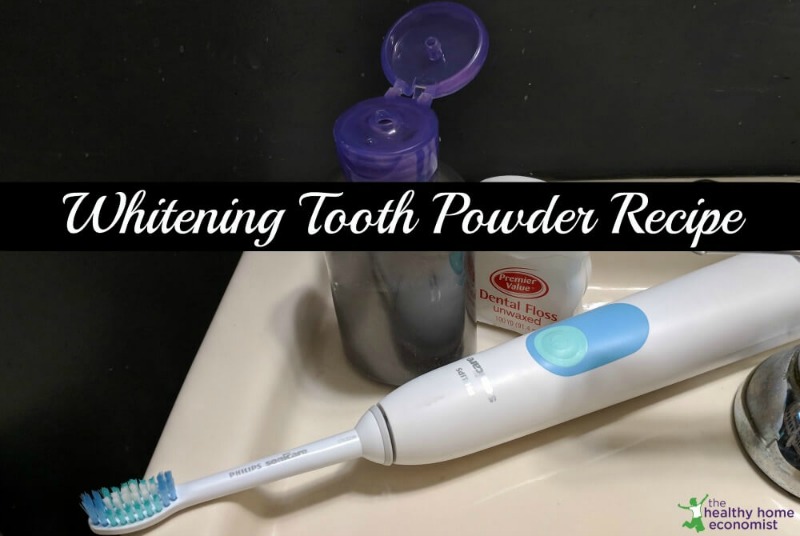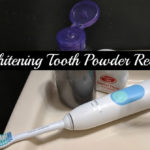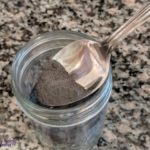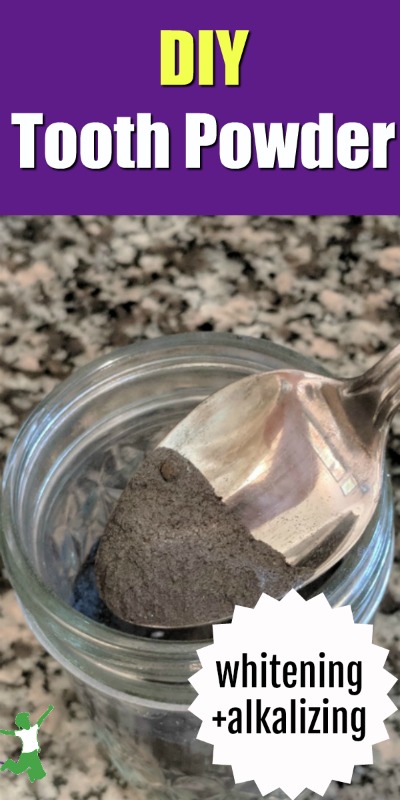Easy recipe for homemade tooth powder rich in organic minerals that whitens teeth and alkalizes the mouth, encouraging remineralization and healthy oral flora.

One of the more popular articles on this blog is a recipe for homemade natural toothpaste. With commercial toothpaste brands overloaded with toxic ingredients (that easily get into the bloodstream via thin gum tissue) and natural versions at the healthfood store very costly, it’s not surprising that people are learning the simple process to make their own!
Since sharing that recipe, I’ve had more than a few requests for a homemade tooth powder. Like natural toothpaste brands at the healthfood store, tooth powders also tend to be a bit expensive. Good-Gums is one that I’ve used in the past, and it is excellent. Shine from Orawellness is another high-quality tooth powder that contains healthful ingredients.
If neither of those two suggestions is in the budget, however, know that you can make your own tooth powder at home easily and inexpensively!
Homemade Tooth Powder
The tooth powder recipe below is based on the two essential ingredients called “The Secret” as recommended by a holistic dentist in my community. Our family has used this basic recipe for almost 15 years. (1)
Notable ingredients include potassium (or sodium) bicarbonate and sea salt to favorably adjust the pH of the mouth from acid to alkaline. The activated charcoal is for nontoxic whitening, and the herbal antibiotic oregano oil is added for its anti-microbial properties. Whole food vitamin C is included as a powerful anti-oxidant.
The cinnamon is most potent when freshly ground. Note that herbs from the store even if organic are months to even years old, which reduces effectiveness considerably. Ceylon cinnamon is best for this recipe as it is sweeter than Cassia or the very spicy Saigon.
Wondering what kind of toothbrush to use? If you prefer electric, Sonicare is the best brand to use (recommended by my Brother-in-Law, who is a periodontist). For manual brushing, a Bass toothbrush is the best toothbrush option due to its uniquely beneficial bristle pattern.
After brushing, be sure to floss ONLY with unwaxed dental floss ideally coated with ozonated oil as recommended by holistic dentists. This protocol helps to improve oral flora. More on how to floss holistically in the linked article.

Whitening Tooth Powder Recipe
Easy recipe for homemade tooth powder that balances oral pH and is anti-bacterial. Also safely whitens without chemicals or toxins. Very cost effective option compared to commercial brands.
Ingredients
- 6 Tbl Potassium bicarbonate or baking soda
- 2 Tbl Finely ground sea salt
- 1 Tbl Whole food Vitamin C NOT ascorbic acid powder
- 1 Tbl Activated charcoal
- 1 tsp Ground cinnamon preferably freshly grated
- 1 drop Oil of oregano optional, added at the time you brush
Instructions
-
Mix all the dry ingredients together well.

-
Store in a small jar or bottle with a tightly fitting lid.
-
To use, wet toothbrush and dip into the powder. Brush your teeth with the powder that adheres to the bristles. Alternatively, sprinkle a small amount of tooth powder into the palm of your hand, mix in 1 drop of oregano oil and then load onto a moistened brush.
-
A Sonicare is the best electric toothbrush to use, and a Bass toothbrush is the best manual toothbrush option.
Recipe Notes
As an alternative to the oil of oregano, mix a few drops of 3% topical hydrogen peroxide with a small amount of the tooth powder in the palm of your hand each time you brush.
Substitute baking soda for the potassium bicarbonate if you prefer.
One more thing … a remineralizing tooth powder is not going to help teeth improve if the diet is terrible. The books Cure Tooth Decay and Cure Gum Disease Naturally are excellent primers on the type of ancestral diets that facilitate optimal oral health.









Sarah — Why not use vitamin C ascorbic acid powder? I inadvertently ordered just that and would not like to have to throw away a product without even using it. Besides, vitamin C is inert without ascorbic acid, right? Thank you!
I would suggest returning it. Using pure ascorbic acid powder would be far too acidic.
On the topic of dental care, I have found that using a waterflosser has been a major help. The dentist barely needs to scrape tartar of my teeth, and my gums have improved. I use it at a low water pressure speed, 4, as some people have said that high pressure could cause bacteria to enter the bloodstream.
Can you recommend a truly holistic dentist in the Orlando area since that is somewhat close to you? Seeing both adults and children. We have tried and have yet to be satisfied with our search.
I recommend Dr. Carlo Litano DMD in Pinellas Park FL. (727) 300-0044 He is our dentist and sees our entire family. He sees young children also.
Mention that The Healthy Home Economist referred you and Dr. Litano will give you 10% off your first visit.
Chewing gum, drinking hot liquids or even just chewing foods releases significant amounts of mercury vapor into the mouth. I think any reaction with peroxide would be minimal compared to that, unless used in teeth bleaching trays where it’s in your mouth of significant amounts of time. I think it’s unnecessary to worry about that. however, I am concerned about the erosion of enamel from the charcoal and have heard that it’s a permanent and negative effect. I am discontinuing my use of charcoal whiteners.
How often do you use the charcoal on your teeth?
Every day until you achieve the level of whiteness you like and then a few times a week after that or maintenance.
Sarah,
Thank you for the info. Any concerns with the coloring of the bristles on the Sonicare? I know it’s a small amount, but still I’ve noticed it eventually wears off… which makes me think it may get ingested and/or is enter the bloodstream via gum tissue?
I don’t think this is a big concern, but you can get brushes with no color. Mine are white.
Hi, I’m wondering about the safety of using activated charcoal when I have an amalgam filling. I’ve been told by my biological dentist that hydrogen peroxide is a no no in my case because it could cause more mercury to get into my system. I’m wondering if the same is true for activated charcoal. I would love to be able to use a whitening powder like this if possible until I can afford to safely replace my amalgam.
This recipe uses oregano oil as the anti-bacterial, H202 is just an option. You can also use colloidal silver safely with amalgams as a tooth powder ingredient. Activated charcoal should be fine too as it ABSORBS stains and toxins unlike H202 which would just release them. Of course, you want to spit the powder out and not swallow it. Double check with your dentist to be sure it is right for you though.
Wouldn’t vitamin C be had on your enamel and what is the reason to put this in there?
If you’ve ever been to a holistic or biological dentist for a cleaning, many times they do a saliva test to check your vitamin C status as this is necessary for proper oral health. Many good quality tooth powders contain small amounts (about 10%) of whole food vitamin C … note that it is not synthetic Vitamin C (ascorbic acid) which is much stronger gram for gram but not necessarily beneficial. I’ve linked to an article above that explores the important differences between ascorbic acid and a pure whole food Vitamin C.
I like your promotion of natural oral care products, and agree they can be very inexpensive to make DIY ones at home.
For an alternative, may I suggest our natural tooth powder, paste, and mouth rinse products that are now all EWG Verified. Please visit our website at naturaltoothhealth dot com
If you are going to the Weston Price convention in Baltimore, please come visit us as we are exhibiting. Thanks Tom Carbone
Do you ever have problems with mold after putting the wet tooth brush into the powder?
The brush should just be moistened, not dripping wet. Believe it or not, the tooth powder remains quite dry as any powder that gets wet adheres to the bristles. I have not had any issues with mold to answer your question.
If this is still a concern, you can always just sprinkle a small amount (1/4 tsp or so) into the palm of your hand and then load onto the moistened toothbrush.